The AMD Radeon R9 Fury Review, Feat. Sapphire & ASUS
by Ryan Smith on July 10, 2015 9:00 AM ESTPower, Temperature, & Noise
As always, last but not least is our look at power, temperature, and noise. Next to price and performance of course, these are some of the most important aspects of a GPU, due in large part to the impact of noise. All things considered, a loud card is undesirable unless there’s a sufficiently good reason – or sufficiently good performance – to ignore the noise.
Starting with voltages, with the latest update to GPU-Z (0.8.4) we now have a basic idea of what the R9 Fury series’ voltages are, so let’s take a look.
| Radeon R9 Fury Series Voltages | |||||
| R9 Fury X (Ref) Load | ASUS R9 Fury Load | Sapphire R9 Fury Load | Sapphire R9 Fury OC Load | ||
| 1.212v | 1.169v | 1.188v | 1.212v | ||
What we find is that the R9 Fury X tops out at 1.212v, a fairly typical voltage for a large 28nm GPU.
Meanwhile what’s of much greater interest is the difference between the two R9 Fury cards. The Sapphire Tri-X R9 Fury OC also tops out at 1.212v, indicating that it’s operating in the same voltage range as the reference R9 Fury X, and what we’d expect to see if AMD isn’t doing any power binning and just selecting Fiji chips for R9 Fury based on yields and attainable clockspeeds. The ASUS card on the other hand reports a notably lower voltage, topping out at 1.169v, 43mv below the Sapphire card.
This is an unexpected, though not unreasonable finding. We know that AMD has been carefully testing chips and more closely assigning operating voltages to them based on what the chips actually need in order to improve their energy efficiency. As a result it looks like the ASUS card ended up with a better chip as part of the overall random distribution of chips, i.e. the chip lottery. We’ll revisit this point in a little bit, but for now it’s something to keep in mind.
Moving on, let’s take a look at average clockspeeds.
| Radeon R9 Fury Series Average Clockspees | ||||
| Game | R9 Fury X (Ref) | ASUS R9 Fury | Sapphire R9 Fury | |
| Max Boost Clock | 1050MHz | 1000MHz | 1040MHz | |
| Battlefield 4 |
1050MHz
|
1000MHz
|
1040MHz
|
|
| Crysis 3 |
1050MHz
|
1000MHz
|
1040MHz
|
|
| Mordor |
1050MHz
|
1000MHz
|
1040MHz
|
|
| Civilization: BE |
1050MHz
|
1000MHz
|
1040MHz
|
|
| Dragon Age |
1050MHz
|
1000MHz
|
1040MHz
|
|
| Talos Principle |
1050MHz
|
1000MHz
|
1040MHz
|
|
| Far Cry 4 |
1050MHz
|
1000MHz
|
1040MHz
|
|
| Total War: Attila |
1050MHz
|
1000MHz
|
1040MHz
|
|
| GRID Autosport |
1050MHz
|
1000MHz
|
1040MHz
|
|
| Grand Theft Auto V |
1050MHz
|
1000MHz
|
1040MHz
|
|
| FurMark |
985MHz
|
902MHz
|
988MHz
|
|
All of these cards are well-cooled, and as a result they have no trouble sustaining their rated clockspeeds when running our benchmark suite games. This is the case even for the ASUS card, which has a much lower power limit, as evidenced by the lower average clockspeed under FurMark.
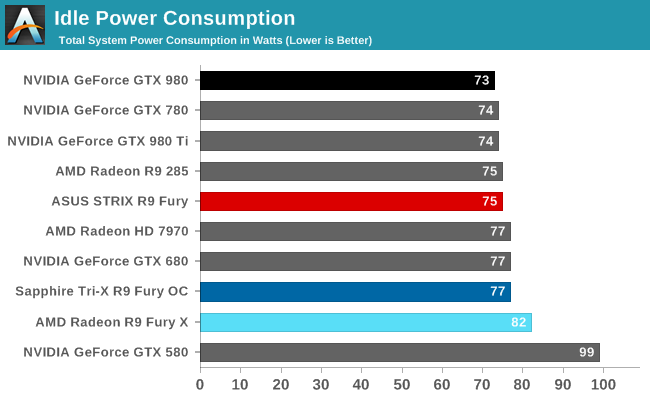
Shifting gears to power consumption, we knew at the time of the R9 Fury X that it was paying a slight idle power penalty as a result of its closed loop liquid cooler, and now we have a better idea of just what that penalty is. It essentially costs AMD another 5W at the wall to run the R9 Fury X’s pump, which means that the air-cooled R9 Fury’s idle power consumption is right in line with other air cooled cards. The fact that the ASUS and Sapphire cards are consistently 2W apart was a bit surprising, though likely a consequence of their difference PCB designs.
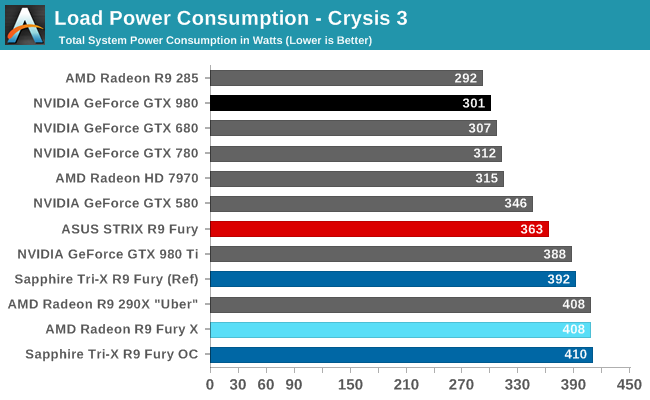
Load power consumption on the other hand is a poignant reminder that the R9 Fury is still a Fiji card, and that AMD can’t match the energy efficiency of NVIDIA’s Maxwell cards even under better circumstances. The Fury cards have a several percent performance lead over the GTX 980, but their power consumption in turn is much, much higher. The difference is between 62W and 109W at the wall, closer to large, power-hungry cards like the R9 Fury X and GTX 980 Ti than the smaller GTX 980 that the R9 Fury is competing with.
Overall the power gap is influenced by several factors. The R9 Fury cards run hotter than R9 Fury X, leading to more leakage. On the other hand disabling some CUs saves power, offsetting the increased leakage. But at the end of the day the R9 Fury is meant to be a 275W TBP card, just like the R9 Fury X, and that’s what we see here.
With that said, the difference between the ASUS and Sapphire cards is extremely surprising. The ASUS card has a lower power limit, but with the card sustaining 1000MHz under Crysis 3, that’s not what’s going on here. Rather we seem to be seeing the result of random chip variation quite possibly combined with ASUS’s custom PCB. Keep in mind what we said earlier about voltages, the ASUS card operates at a lower voltage than the Sapphire card, and as a result it has an advantage going into our power testing. Still, I would normally not expect a 43mv difference to lead to such significant savings.
This is a particular case where I’m curious what we’d find if we tested multiple ASUS cards, rather than looking at a sample size of 1. Would other ASUS cards have worse chips and draw more power? We’d expect so, but there may still be an advantage from ASUS’s PCB design and BIOS that need to be accounted for. At the very least it helps to close the efficiency gap between the R9 Fury and GTX 980, but it’s still not going to be enough.
Finally, since Sapphire also sent over the stock BIOS for their card we quickly tested that as well. Power consumption is down slightly thanks to slightly lower clockspeeds coupled with a lower maximum voltage of 1.188v. Still, even configured as a stock card, the ASUS card is well ahead in energy efficiency.
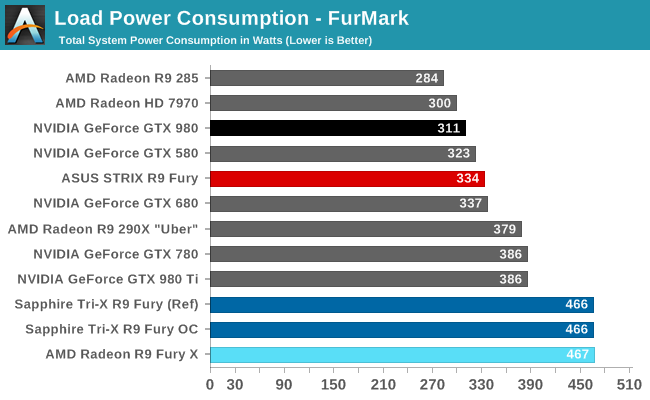
As for FurMark, we get the results more or less exactly what we were expecting. The Sapphire card with its AMD reference PCB and the high power delivery limits that entails throttles very little on FurMark, and as a result power consumption at the wall is quite high. On the other hand the ASUS card has its much lower default power limit, resulting in much heavier throttling under FurMark and keeping maximum power consumption down as well.
The end result is that the Sapphire card has a much wider range than the ASUS card, and it also indicates that the ASUS card’s power limit is likely not very far above what it takes to sustain 1000MHz under most games. The ASUS card will likely need more power to avoid power throttling if overclocked.
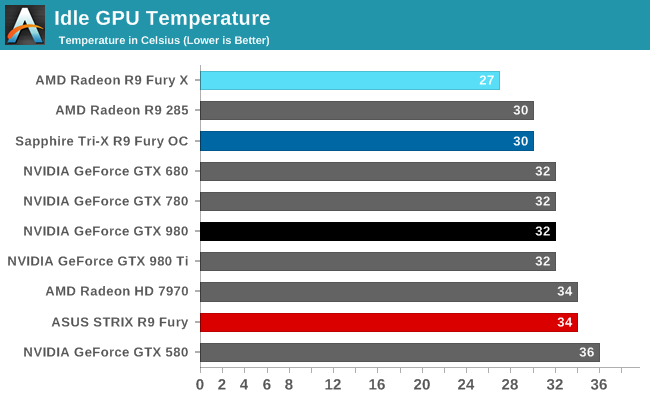
Moving on to idle temperatures, both R9 Fury cards fare relatively well here. The fact that they have no active cooling due to their zero fan speed idle technologies means that they run a bit warmer at idle, but it’s nothing significant.
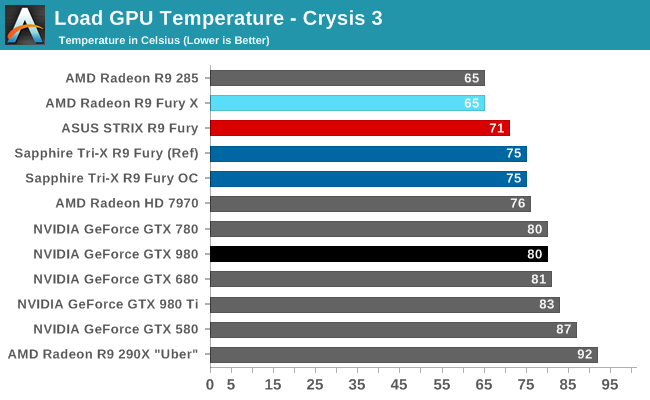
Crysis 3 temperatures meanwhile are in-line with what these cards are designed for. The Sapphire card is designed to run at up to 75C, and that’s exactly what happens here. The ASUS card on the other hand is a bit more aggressive with its fan early on, leading to it topping out at 71C. Both, as expected, are warmer than the R9 Fury X, which is not a major problem, but it does contribute to the lower energy efficiency we’ve been seeing, particularly for the Sapphire card.
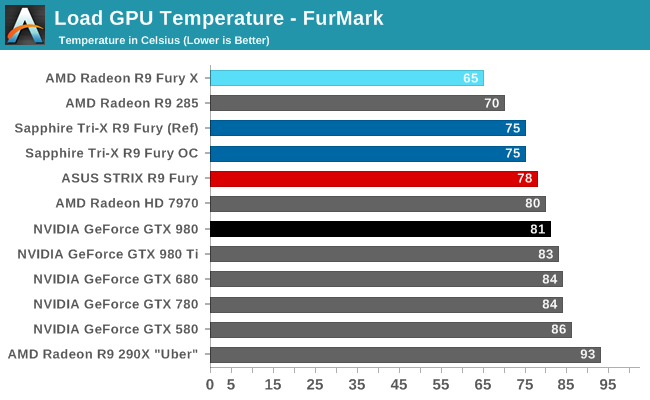
FurMark on the other hand changes things slightly. The Sapphire card holds at 75C and ramps up its fan, while the ASUS card is already operating at its first fan speed limit, and as a result is allowed to increase in temperature instead. What’s holding back the ASUS card at this point and preventing it from getting warmer yet is its power limit; the card can only generate enough heat to get up to 78C with its fans running at their first limit.

Last but not least, we have our noise measurements, starting with idle noise. The Sapphire and ASUS cards both feature zero fan speed idle technology, which means neither card is running their fans here. As a result the cards are outright silent. What we end up measuring is the background noise, mainly the fans and pumps of our CPU’s closed loop liquid cooler. At this point zero fan speed idle technology is not cutting edge, but it is never the less impressive. High-end HTPC users, or just users looking for a very quiet card at idle should be very happy with either card.

When it came time to run our load noise testing we were expecting good things from both cards, but the results from the Sapphire Tri-X have completely blown our expectations. With sub-40dB(A) noise levels we ended up running our load noise test three different times in order to make sure there wasn’t an error in our testing methodology. There wasn’t.
What we have here then is the quietest high power air cooled card we have ever tested. In its OC configuration the Sapphire Tri-X card tops out at 38.2dB under Crysis 3, less than 2dB(A) above our noise floor and nearly 5dB quieter than the quiet R9 Fury X. Switching to its reference configuration drives noise levels down even further, to just 37.8dB(A). To put that in perspective, the Sapphire Tri-X under a gaming workload is as loud as the GTX 980 Ti is at idle. Simply put, these results are amazing.
In going over the design of Sapphire’s card there is no doubt that this is the product of several factors – not the least of which is the massive heatsink – but going back to what we said earlier about the short PCB, we’re left to wonder if that didn’t have a significant impact. By being able to blow hot air straight back (or rather, straight up), the card reduces the amount of airflow and noise being reflected against the back of the card, but it also offers a more direct cooling route that in principle reduces the amount of work the fans need to do. In any case we’ve seen Sapphire’s Tri-X cards do well before, but at 38dB(A) this is a new high water mark that is going to be difficult to beat.
Which on that note, puts the ASUS card in an awkward position. Compared to just about anything else, 46.2dB would be doing well for an open air card. But at an 8dB(A) difference between it and the Sapphire card, the difference is night and day. ASUS has to run their fans so much faster that they just can’t match what Sapphire has done. It’s a solid card, but when it comes to acoustic testing it has the misfortune of going up against some very capable competition.
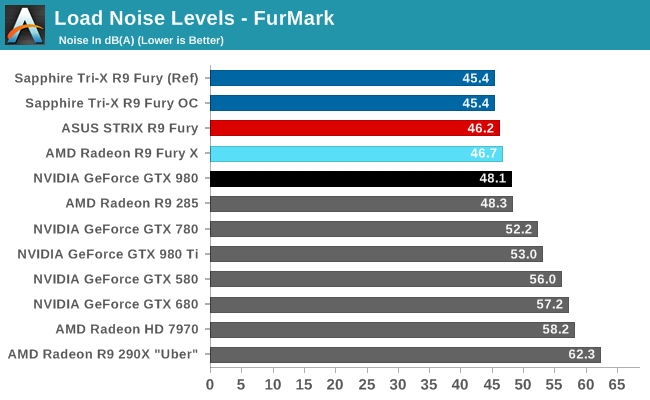
Finally we have our noise levels under FurMark. What’s interesting here is that with the ASUS card still running at its first maximum fan speed (44%), it doesn’t get any noisier under FurMark than it does Crysis 3. The Sapphire card on the other hand does need to ramp up its fans significantly to handle the extra heat. None the less the Sapphire card still ends up being a bit quieter, topping out at 45.4dB. And when taking into consideration the significant difference in power limits between the two cards, it’s clear that the Sapphire card is remaining quieter while performing a great deal more work.










288 Comments
View All Comments
CiccioB - Monday, July 13, 2015 - link
The myth, here again!Let's see these numbers of a miraculous vs crippling driver.
And I mean I WANT NUMBNERS!
Or what you are talking about is just junk you are reporting because you can't elaborate yourself.
Come on, the numbers!!!!!!!!!
FlushedBubblyJock - Thursday, July 16, 2015 - link
So you lied loguerto, but the sad truth is amd bails on it's cards and drivers for them FAR FAR FAR sooner than nvidia does.YEARS SOONER.
Get with it bub.
Count Vladimir - Thursday, July 16, 2015 - link
Hard evidence or gtfo.Roboyt0 - Sunday, July 12, 2015 - link
I am very interested to see how much of a difference ASUS' power delivery system will make for (real) overclocking in general once voltage control is available. If these cards act the same as the 290's did, then AMD's default VRM setup could very likely be more than capable of overclocks in the 25% or more range. I'm basing the 25% or more off of my experience with a half dozen reference based R9 290's, default 947MHz core, that would reach 1200 core clock with ~100mV additional. And if you received a capable card then you could surpass those clocks with more voltage.It appears AMD has followed the EXACT same path they did with the 290 and 290X. The 290X always held a slight lead in performance, but the # of GPU components disabled didn't hinder the 290 as much as anyone thought. This is exactly what we see now with the Fury ~VS~ Fury X...overclock the Fury and it's the better buy. All while the Fury X is there for those who want that little bit of extra performance for the premium, and this time you're getting water cooling! It seems like a pretty good deal to me.
Once 3rd party programmers(not AMD) figure out voltage control for these cards, history will likely repeat itself for AMD. Yes, these will run hotter and use more power than their Nvidia counterparts...I don't see why this is a shock to anyone since this is still 28nm and similar enough to Hawaii...What no one seems to mention is the amount of performance increase compared to Hawaii in the same power/thermal envelope..it's a very significant jump.
Whom in the enthusiast PC world really cares about the additional power draw? We're looking at 60-90W under normal load conditions; Furmark is NOT normal load. Unless electricity where you hail from is that expensive, it isn't actually costing you that much more in the long run. If you're in the market for a ~$550 GPU, then you probably aren't too concerned with buying a good PSU. What the FurMark power draw of the Fury X/Sapphire Fury really tell us is that the reference PCB is capable of handling 385W+ of draw. This should give an idea of what the card can do once we are able to control the voltage.
These cards are enthusiast grade and plenty of those users will remove the included cooler for maximum performance. A full cover waterblock is going to be the key to releasing the full potential of Fury(X) just like it was for 290(X). It is a definite plus to see board partners with solid air cooling solutions out of the gate though...Sapphire's cooling solution fares better in temperature AND noise during FurMark than ASUS' when it's pulling 130W additional power! Way to go Sapphire!
My rant will continue concerning drivers. Nvidia has mature hardware with mature drivers. The fact AMD is keeping up, or winning is some instances, is a solid achievement. Go back to a 290(X) review when their primary competition was a 780 Ti, where the 780 Ti was usually winning. Now, the 390(X), that so many are calling a rebranded POS, easily bests the 780 Ti and competes with GTX 980. Nvidia changed architecture, but AMD is still competitive? Another commenter said it best by saying: "An AMD GPU is like a fine wine, and gets better with age."
This tells me 3 things...
1) Once drivers mature, AMD stands to gain solid performance improvements.
2) Adding voltage control to enable actual overclocking will show the true potential of these cards.
3) Add these two factors together and AMD has another winning product.
Lastly we still have DX12 to factor into all of this. Sure, you can say DX12 is too far away, but in actuality it is not. I know there are those people who MUST HAVE the latest and greatest hardware every time something new comes around every ~9 months. However, there are plenty more of us who wait a few generations of GPUs to upgrade. If DX12 brings even a half of the anticipated performance gains and you're in the market, then purchasing this card now, or in the coming months, will be a solid investment for the coming years.
Peichen - Monday, July 13, 2015 - link
Whatever flats your boat. There are still some people like you that believes FX CPUs are faster than i7s and they are what keeps AMD afloat. The rest of us.... we actually consider everything and go Intel & Nvidia.There are 3 fails in your assumptions:
1. Fiji is a much bigger core tied to 4 HBM modules. OC will likely not be as "smooth" as 290X
2. 60-90W is not just cost in electricity. It is also getting a PSU that will supply the additional draw and more fan(s) and better case to get the heat out. Or suffer the heat and noise. The $15-45 a year in additional electricity bill also means you will be in the red in a couple od years.
3. You assume AMD/ATI driver team is still around and will be around a couple of years in the future.
silverblue - Tuesday, July 14, 2015 - link
3. Unless the driver work has been completely outsourced and there's proof of this happening, I'm not sure you can use this as a "fail".Fiji isn't a brand new version of GCN so I don't expect the huge gains in performance that are being touted, however whatever they do bring to the table should benefit Tonga as well, which will (hopefully) distance itself from Tahiti and perhaps improve sales further down the stack.
Count Vladimir - Thursday, July 16, 2015 - link
Honestly, driver outsourcing might be for the best in case of AMD.Oxford Guy - Wednesday, July 15, 2015 - link
The most electrically efficient 3D computer gaming via an ARM chip, right? Think of all the wasted watts for these big fancy GPUs. Even more efficient are text-based games.FlushedBubblyJock - Thursday, July 16, 2015 - link
You forgot he said spend a hundred and a half on a waterblock...for the amd card, for "full potential"..ROFL - once again the future that never comes is very bright and very expensive.
beck2050 - Monday, July 13, 2015 - link
A bit disingenuous as custom cooled over clocked 980s are the norm these days and easily match or exceed Fury, while running cooler with much less power and can be found cheaper. AMD HAS its work cut out.